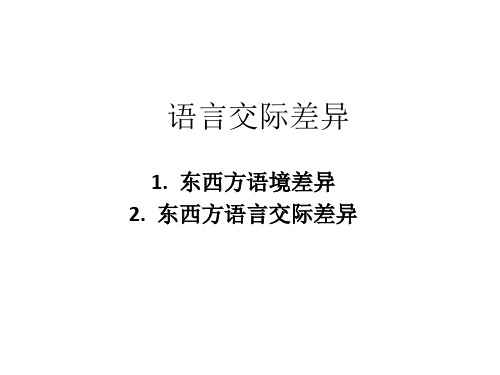全面的跨文化交际课件
合集下载
跨文化交际 ppt课件

美国人的会话风格
• 其主流语言风格被视为“体谅模式”,主要以 加州为主。
• 另一种语言风格为“参与模式”,以纽约为主 。
交际方式
• 东方人采取单向的保龄球方式。 • 西方人采取的是双向的乒乓球式。
非语言交际差异
非语言交际的定义
• 在交际过程中不是用口头或文字形式进行 信息传递的沟通方式即为非语言交际
• A lucky dog. • As faithful as a dog. 走狗 • Work as hard as a dog. 老黄牛 • 汉语:狗急跳墙,狗血喷头,狗眼看人低,
狗拿耗子多管闲事,狗嘴里吐不出象牙。狗 咬吕洞宾,不识好人心。
(美国)象征着死亡,祭奠亡灵和扫墓时 使用,相当于菊花。(主要用于复活节)
讨论: 鱼在英语中的含义?
• Fish in the air • 水中捞月 • A poor fish • 可怜虫 • A loose fish • 放荡不羁者 • A small fish
颜色词的文化差异,如红色、白色和黄色。 • 红色:happy, health,luck. 红对联、红包、红
3. What’s up? Can’t complain./Same as usual.
2. 东西方称呼语差异
• 东方人在称呼上更强调地位、辈份和身份。 • 西方人则更突出性别和婚姻。 • 东方人通常将姓氏放在名字的前面。 • 亚洲许多国家例如中国、韩国、越南,女
性婚后一般不随夫姓。
• 西方人大多习惯将名字放在姓氏之前,在 西方文化中,女人结婚后要随其丈夫的姓 氏。
• 这一部分需要大家课后去搜索:请找出尽 可能多的手势差异,如ok的手势语,竖起 大拇指的手势语等。
跨文化交际障碍
跨文化交际 全套课件

• 3.in the west ,if you were invited to have a meal at someone’s home, there will often be only one or two dishes.Even it was a formal dinner, it would usually be just three courses:soup, main dish, and desert. But in China,an informal dinner would have four dishes and a soup; a a formal dinner would have at least eight dishes and a soup.
• 1.There are at least two or more people.
• 2.There must be some contact between communicators.
• 3.There must be a language shared by communicators.
• 4.an exchange of information has taken place.
communication
• Activity 2 meanings in communication
• Utterance meaning :what it normally means
• Speakers meaning:the speaker has intended to convey by way of utterance meaning .
• 5.Many people feel religious belief are very personal and they may not feel; comfortable to tell someone they hardly know.
大学跨文化交际ppt课件

3. 面对分歧与冲突:尊重对方观点,妥善 处理分歧,学会妥协与包容。
05
06
4. 实践建议:加强语言学习,提高沟通技 巧,主动参与社交活动,保持开放心态。
05
跨文化交际能力的培养与提升
增强文化意识与敏感度
01
了解不同文化的价值 观和世界观
深入了解不同文化的价值观和世界观 ,可以帮助我们更好地理解其他文化 ,避免跨文化交际中的误解和冲突。
发展
随着全球化的深入,跨文化交际研究逐渐涉及更多 领域,包括语言学、心理学、管理学等。
当代趋势
如今,跨文化交际能力被越来越多的行业和 领域视为必备技能,如国际商务、外交、教 育等。
02
跨文化交际的核心能力
文化敏感度
01 意识到文化差异的存在
02 理解和尊重文化差异
03
愿意学习和适应不同文化
语言能力
02
关注文化细节
在跨文化交际中,细节往往可以反映 出一个人的文化背景和习惯。增强对 文化细节的敏感度,可以帮助我们更 好地适应不同的文化环境。
03
培养文化包容心态
接受并尊重不同文化的差异,以包容 的心态去面对其他文化,可以增强我 们的文化意识,提高跨文化交际能力 。
提高语言能力与交际技巧
Hale Waihona Puke 学习目标语言在不同文化环境中进行决策和解 决问题的能力
03
在不同文化环境中处理冲突和压 力的能力
04
03
跨文化交际的挑战与应对策略
文化冲击与文化适应困难
总结词
文化冲击是指人们在接触另一种文化时,由于价值观、信仰、习惯等方面的差异,产生的困惑、恐惧和不安。
详细描述
文化冲击的症状包括孤独感、思乡病、易怒和焦虑等。适应新文化需要时间,正确认识和接受这种变化是克服文 化冲击的关键。
跨文化交际PPT演示课件

23
3. Space and Distance
3.1 Proxemics 3.2 Attitudes Toward Crowding
24
3.1 Proxemics
✓ Definition: the study of people’s perception and use of space.
✓ Four categories: intimate, personal, social, and public distance.
26
Categories of Distance (cont’d)
• Social Distance (1.3-3m) - colleagues, business partners, people at social gatherings
• Public Distance (beyond 3m) - speaking in public
- direct intrusion into others’ affairs • Shrugging shoulders
- indifferent, powerless, having no secret to conceal
19
Postures (cont’d)
• Follow one’s natural habits so often go unnoticed (subconscious in nature)
• May damage your image if you neglect your postures
20
2.4 Eye Contact
Direct eye contact • Chinese: avoid • North Americans: appreciate • The British: avoid
3. Space and Distance
3.1 Proxemics 3.2 Attitudes Toward Crowding
24
3.1 Proxemics
✓ Definition: the study of people’s perception and use of space.
✓ Four categories: intimate, personal, social, and public distance.
26
Categories of Distance (cont’d)
• Social Distance (1.3-3m) - colleagues, business partners, people at social gatherings
• Public Distance (beyond 3m) - speaking in public
- direct intrusion into others’ affairs • Shrugging shoulders
- indifferent, powerless, having no secret to conceal
19
Postures (cont’d)
• Follow one’s natural habits so often go unnoticed (subconscious in nature)
• May damage your image if you neglect your postures
20
2.4 Eye Contact
Direct eye contact • Chinese: avoid • North Americans: appreciate • The British: avoid
《跨文化交际》课件

跨国企业的跨文化团队建设案例
总结词
跨国企业通过跨文化团队建设,实现文化融合与协同发展。
详细描述
某跨国企业为应对不同国家和地区的文化和市场差异,组建了由不同国籍员工组成的跨文化团队。通过培训、交 流活动等方式,促进员工之间的文化了解与合作,实现了企业业务的快速发展。
国际旅游中的跨文化冲突解决案例
总结词
教师需要关注学生的文化背景和个性特点,采用多样化 的教学方法和手段,促进学生的学习和发展。
教育机构需要提供跨文化交际的培训和教育,帮助学生 和教师了解不同文化的特点和差异。
教育中的跨文化交际有助于培养具有国际视野和跨文化 交际能力的人才,推动全球化和文化交流。
国际关系中的跨文化交际
01
国际关系中的跨文化交际是指在不同国家之间进行有效的沟通和合作 。
THቤተ መጻሕፍቲ ባይዱNKS
感谢观看
02
CATALOGUE
文化差异的表现
语言差异
语言差异是跨文化交际中最为直观的表现。不同文化背景的 人们使用不同的语言,这可能导致沟通障碍。例如,某些词 汇在一种文化中可能有特定的含义,而在另一种文化中可能 没有。
语言使用的习惯和规则也因文化而异,如敬语的使用、礼貌 的表达方式等。了解和尊重这些差异是进行有效跨文化交际 的关键。
详细描述
某高校开展国际交流项目,邀请不同国家和地区的留学生和学者参与学术交流、文化体 验等活动。通过这些项目,学生和学者增进了对不同文化的了解,促进了国际合作与友
谊。
国际组织中的跨文化沟通案例
总结词
国际组织中的跨文化沟通,推动全球议题的 解决。
详细描述
某国际组织在处理全球性议题时,注重跨文 化沟通与合作。组织成员来自不同国家和地 区,拥有不同的文化背景和观念。通过有效 的跨文化沟通,成员们达成共识,推动了全 球性议题的解决。
《跨文化交际》课件

2
基本规则
了解跨文化交际的基本规则,如注重非语言沟通、避免使用俚语和难懂的语言等方的文化背景和习惯,调整沟通策略,确保信息的准确传达。
解决跨文化交际中的问题
1 展示文化敏感性
在跨文化交际中,需要对不同文化背景的人 表示尊重和理解。
2 调整沟通策略
针对跨文化交际中遇到的问题,我们可以根 据对方的习惯和背景,调整沟通策略,解决 问题。
案例研究
跨文化交际成功案例
一位跨国公司的领导成功地进行了跨文化沟通,在 不同国家的员工中建立了良好的合作关系。
跨文化交际失败案例
因为文化差异,一个国际项目中的交流出现了误解 导致该项目未能按时完成。
总结与讨论
反思课程内容
通过本课程的学习,您是否更好地了解了跨文化交际的重要性和技巧?
提出问题和建议
《跨文化交际》PPT课件
本课程旨在帮助您更好地了解跨文化交际的重要性和技巧,并掌握如何有效 地与不同文化背景的人交流。
什么是跨文化交际?
定义
跨文化交际是指在跨越不同文化背景的情况下进行的交流和互动。
重要性
随着全球化进程的加快,跨文化交际的重要性越来越受到重视。
挑战
不同文化之间的交流可能会面临很多挑战和障碍,需要我们采取有效的沟通策略。
在跨文化交际的实践中,您是否遇到了问题?为了更好地提高跨文化交际的能力,您有什么 建议?
文化差异
不同的文化特征
每个文化都有自己独特的特征,例如语言、信仰、 价值观和习俗。
文化差异的影响
文化差异可能会影响人们的观念、行为和与他人的 交流方式。
文化融合
跨文化交际也是文化融合的过程,可以促进不同文 化之间的理解和尊重。
跨文化沟通技巧
《跨文化交际》课件

尊重他人
尊重和接受不同文化的观点 和做法。
发展人际关系
建立良好的人际关系有助于 跨文化交际的顺利进行。
结论和总结
跨文化交际是一个复杂而有趣的领域,它可以丰富我们的视野,增进人与人之间的理解和合作。在全球化的时 代,跨文化交际的重要性不可忽视。
自由民主
西方社会价值观的核心之一,强调个人自由和人权。
摇滚音乐
西方音乐文化的代表,让人们释放情感和表达自我。
跨文化交际的概念
跨文化交际是指不同文化背景的人之间进行有效沟通和交流的过程。
跨文化交际的重要性
1 提高理解力
通过跨文化交际,我们能够更好地理解和尊重他人的文化。
2 促进合作
跨文化交际有助于不同文化背景的人们共同合作解决问题。
《跨文化交际》PPT课件
跨文化交际是研究不同文化间的交流,了解和尊重不同文化背景的重要性。
中国文化
长城
茶道
中国古代的伟大建筑物,象征着 中国的辉煌历史和文化的丰富性。
中国独特的文化艺术,展示了对 礼仪和和谐的追求。
书法
中国的艺术形式,以笔刷和墨水 书写汉字,传承了上千年的历史。
西方文化
圣诞节
西方重要的节日,在这一天人们庆祝和分享快乐。
3 推动创新
不同文化间的交流和碰撞能够激发创新思维,产生新的想法和解决方案。
跨文化交际中的挑战
1
语言障碍
不同语言之间的差异可能导致交流困难。
2
文化差异
不同文化的价值观和习俗可能造成误解和冲突。
3
沟通风格
跨文化交际中的沟通方式和风格可能不同,需要灵活适应。
跨文化助于更好 地交流和理解。
跨文化交际概述课件

04
跨文化交际在全球化时代 的意义与价值
促进国际合作与交流
增进国际间的了解和友谊
通过跨文化交际,人们可以了解其他国家和文化,进而促进国际 间的合作和友谊。
促进国际商务谈判
在全球化时代,国际商务谈判中涉及不同文化和背景的人员,跨文 化交际能力能够有效地促进谈判进程。
推动国际援助和合作
在应对全球性问题如气候变化、疫情等事件中,跨文化交际能够帮 助不同国家之间建立合作,共同应对挑战。
案例三
一家中国公司与一家法国公司的合作项目,由于语言、文化和商业习惯的差异,双方在谈 判中遇到了困难。经过长时间的沟通和协商,双方最终达成了共识,并成功完成了合作项 目。
跨文化交际实践经验分享
经验一
尊重对方的文化和习惯,不要轻易评价和批评。在沟通中要注意细 节和礼仪,避免冒犯对方。
经验二
学习并掌握对方的语言和文化背景知识,以便更好地理解和沟通。 在沟通中要使用正确的语言和表达方式,避免歧义和误解。
经验三
保持开放的心态和积极的态度,决方案。
跨文化交际失败案例反思与总结
案例一
一位中国员工在与一位美国同事沟通时,由于语言和文化 差异,产生了误解和冲突。双方没有及时沟通和解决,导 致关系恶化。
案例二
一家中国公司与一家德国公司的合作项目,由于文化差异 和商业习惯的不同,双方在合作中出现了很多矛盾。最终 合作失败,双方都遭受了损失。
语言障碍与沟通障碍
1 2 3
语言障碍
不同语言之间的交流障碍是跨文化交际中的常见 问题,这可能导致误解和沟通困难。
非语言沟通差异
不同文化背景的人可能使用不同的非语言沟通方 式,如肢体语言、面部表情等,这可能导致误解 和沟通困难。
- 1、下载文档前请自行甄别文档内容的完整性,平台不提供额外的编辑、内容补充、找答案等附加服务。
- 2、"仅部分预览"的文档,不可在线预览部分如存在完整性等问题,可反馈申请退款(可完整预览的文档不适用该条件!)。
- 3、如文档侵犯您的权益,请联系客服反馈,我们会尽快为您处理(人工客服工作时间:9:00-18:30)。
1. What is culture?
On the surface: customs and behavior More deeply: what the behavior and customs mean to the people who are following them
In a word: Culture is all about meanings
2
Elements of communication
• Context (location, time, light, temperature, seating arrangements)
• Participants (relationship, gender, culture) • Messages (meanings, symbols, encoding
Hall: Culture is everything and everywhere
1
4. What is Communication?
• It comes from the Latin word “communicare”, it
means to give or to exchange. Now, the most common meaning of “communication” is to give or exchange information or ideas. • Communication is our ability to share our ideas and feelings. (the basis of all human contact) • Communication is a dynamic, systematic process in which meanings are created and reflected in human interaction with symbols. (J.T.Wood)
6
6. Intercultural Communication
• Samovar & Porter
Intercultural communication is communication between people whose cultural perceptions and symbol systems are distinct enough to alter the communication event.
intercultural communication refers to any communication between two members of any cultural communities.
7
Intercultural Communication Vs
Cross-cultural Communication
Linear Model of Communication
Sender
encoding
noise
Channel (message)
decoding
Receiver
Is this an effective model of communication?
4
Interactive Model of Communication
• 1) Communication is dynamic
• 2) Communication is interactive
• 3) Communication is irreversible
• 4) Communication takes place in both a physical and social context.
• Cross-cultural communication the similarities and differences in value orientations, affective dispositions, relationship management, communicative styles (psychological process)
decoding
message / channel
encoding
Sender Receiver
noise
Sender Receiver
encoding
message / channel
decoding
Feedback is essential to good comracteristics of communication
• One man’s meat is another man’s poison. ---- English proverb
• God gave to every people a cup, cup of clay, and from this cup they drank life… They all dipped in the water, but their cups were different. ---- R. Benedict
and decoding) • Channels (sound, sight, smell, taste, touch) • Noise (external noise, internal noise,
semantic noise) • feedback
3
Mode of Communication
• Intercultural communication the penetration by a member of one culture into another culture (practical significance)
8
Warm-up: Read the following sayings aloud, and
discuss with your partner: what do they mean to you?
• Human beings draw close to one another by their common nature, but habits and customs keep them apart. ---- Confucian saying
On the surface: customs and behavior More deeply: what the behavior and customs mean to the people who are following them
In a word: Culture is all about meanings
2
Elements of communication
• Context (location, time, light, temperature, seating arrangements)
• Participants (relationship, gender, culture) • Messages (meanings, symbols, encoding
Hall: Culture is everything and everywhere
1
4. What is Communication?
• It comes from the Latin word “communicare”, it
means to give or to exchange. Now, the most common meaning of “communication” is to give or exchange information or ideas. • Communication is our ability to share our ideas and feelings. (the basis of all human contact) • Communication is a dynamic, systematic process in which meanings are created and reflected in human interaction with symbols. (J.T.Wood)
6
6. Intercultural Communication
• Samovar & Porter
Intercultural communication is communication between people whose cultural perceptions and symbol systems are distinct enough to alter the communication event.
intercultural communication refers to any communication between two members of any cultural communities.
7
Intercultural Communication Vs
Cross-cultural Communication
Linear Model of Communication
Sender
encoding
noise
Channel (message)
decoding
Receiver
Is this an effective model of communication?
4
Interactive Model of Communication
• 1) Communication is dynamic
• 2) Communication is interactive
• 3) Communication is irreversible
• 4) Communication takes place in both a physical and social context.
• Cross-cultural communication the similarities and differences in value orientations, affective dispositions, relationship management, communicative styles (psychological process)
decoding
message / channel
encoding
Sender Receiver
noise
Sender Receiver
encoding
message / channel
decoding
Feedback is essential to good comracteristics of communication
• One man’s meat is another man’s poison. ---- English proverb
• God gave to every people a cup, cup of clay, and from this cup they drank life… They all dipped in the water, but their cups were different. ---- R. Benedict
and decoding) • Channels (sound, sight, smell, taste, touch) • Noise (external noise, internal noise,
semantic noise) • feedback
3
Mode of Communication
• Intercultural communication the penetration by a member of one culture into another culture (practical significance)
8
Warm-up: Read the following sayings aloud, and
discuss with your partner: what do they mean to you?
• Human beings draw close to one another by their common nature, but habits and customs keep them apart. ---- Confucian saying
